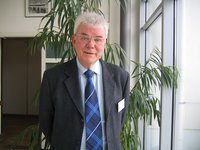-
Overview
-
Topics
- E-MRS Fall Meeting 2006 homepage
- Invited talks of Plenary session
- Nanostructured composite films: synthesis, characterization, properties, and applications
- Nanomaterials in catalysis
- Doped nanopowders: synthesis, characterisation, applications
- Polymer materials modified by nanoparticles
- Dilute magnetic materials for spintronic applications
- Wide Band Gap II-VI Semiconductors: Growth, Characterization and Applications
- Multiscale kinetic modelling of materials
- Phase Diagrams, Phase Stability: Theory and Applications
- Surface functionalization and activation of biomaterials
- Complex oxide materials for new technologies
- Following companies welcome you at their booth
-
Satellite events
-
Register
- Registration and abstract submission closed
- Book of abstracts
- On-line timetable
- Event statistics
- On-line journal
-
Archives
Programme
Over the last 15 years, biomaterials research is oriented to the activation of biomaterial surfaces in order to optimise tissue integration of medical devices. At the present state-of-the-art, functionalization is turning around the grating of polyacrylic acid or polyethylene glycol as spacer molecules for further binding of bioactive molecules such as extracellular matrix constituents, but without any eminent progress. - Since now about 5 years several laboratories have enhanced their competences to develop new technologies in order to obtain biocompatible materials with functionalised surfaces. Several means are available in particular the grafting of bioactive molecules (i) via new spacer molecules to stimulate the target to go to the material surface, and (ii) via cage molecules to provide controlled drug delivery systems. Most of these methods can be applied on all implantable materials, and they are in particular very useful and forthcoming for scaffolds, hybrid medical devices and tissue engineering.
The aim of this symposium is to generate more scientific and industrial co-operation between technical, biological and medical domains. It will subsequently largely be open to researchers from multiple disciplines such as material science and engineering, mineral and organic chemistry, (bio)physics, electro-chemistry, analytics, cell and molecular biology, pharmacology, medicine (orthopaedics, dentistry, ophthalmology, cardiology, urology, visceral surgery).
This symposium will cover wide multidisciplinary fields from Material Science (metals, ceramics, polymers), Surface Physico-chemistry, Cell Biology, Biochemistry, Macromolecular Chemistry to achieve the improvement of interface interactions and subsequently of tissue integration of medical devices.
The main topics of the symposium will be:- Surface tailoring: physical and chemical surface characterizations; surface formulation, surface energy,
- Physical and chemical molecular grafting: extracellular matrix constituents, spacer and/or cage molecules;
- Cytochemical immune-labelling: cytoskeleton, extracellular matrix, focal adhesion contacts; cell membrane receptors, pro-inflammatory markers;
- Nanopaterning and nanostructural devices;
- Interaction between biomaterials surfaces with bioactive molecules and cells, cell adhesion;
- Endogenous biomimetic coatings in appropriate fluids
- Controlled drug delivery systems;
- Immobilization of bioactive molecules;
- Tissue engineering
Scientific Committee:
L. BORDENAVE (France), M. CREPIN (France), K. DE GROOTE (Netherlands), Q. L. FENG (China), D. GRANT (U.K.), V. HARABAGIU (Romania), U. M. LOSERT (Austria), Y. H. KIM (Korea), C. J. KIRKPATRICK (Germany), O. MELNYK (France), C. MIGLIARESI (Italy), M. MORCELLET (France), J. RYCHLY (Germany), B. C. SIMIONESCU (Romania), M. TEXTOR (Switzerland), Y. M. ZHAO (Chine), G. ZIEGLER (Germany).
Tentative list of invited speakers:
- R. BARBUCCI (University of Siena, Italy): Microstructured materials for cell guidance
- Th. GROTH (University of Halle, Germany): Chemical and physical surface modification of biomaterials to control adhesion of cells
- C. J. KIRKPATRICK (University of Mainz, Germany): Outgrowth of endothelial cells from human peripheral blood on nanometric fibroin nets
- R. THULL (University of Würzburg, Germany): Physicochemical, molecular and cellular events of the interaction between metallic implants and biological systems
- T. J. WEBSTER (Dept. Biomedical Engineering, Purdue University, IN - USA): Nanotechnology for treating damaged organs: A collection of in vivo studies
- H. PODBIELSKA (Wroclaw University of Technology, Poland) Silica sol-gel matrix doped with photolon molecules for sensing and medical therapy purposes
- J. SAN ROMAN (Instituto de Polimeros - CSIC, Madrid, Spain) New polymer drugs as bioactive surface coatings for drug eluted coronary stents
- W. ŚWIĘSZKOWSKI, (Warsaw University of Technology, Poland) Repair and regeneration of osteochondral defects in the articular joints
Organisers
- Hartmut F. HILDEBRAND, Biomaterials Research Laboratory, Lille Medical University, Lille (France)
- Julio SAN ROMAN, CSIC, Institute of Science and Technology of Polymers, Madrid (Spain)
- Barbara NEBE, Dept. of Internal Medicine/Clinical Research, Rostock Medical University, Rostock (Germany)
- Joelle AMEDEE, Inserm U577 - Biomaterials and Tissue Repair, University Bordeaux-2 (France)
Proceedings
The manuscripts submitted to this symposium and accepted on the basis of the referee procedure adopted for regular papers would be published in the international scientific journal "Biomolecular Engineering".Contact
Hartmut F. HILDEBRAND
Directeur de Recherche INSERM
Groupe Recherche Biomatériaux
Laboratoire de Biophysique UPRES EA 1049
Faculté de Médecine "H. Warembourg"
1, place de Verdun
59045 LILLE cedex
Fax: + 33/(0)320 62 68 54
E-mail: [email protected]
 Prof. Hartmut F. Hildebrand - Symposium
Chairman
Prof. Hartmut F. Hildebrand - Symposium
Chairman